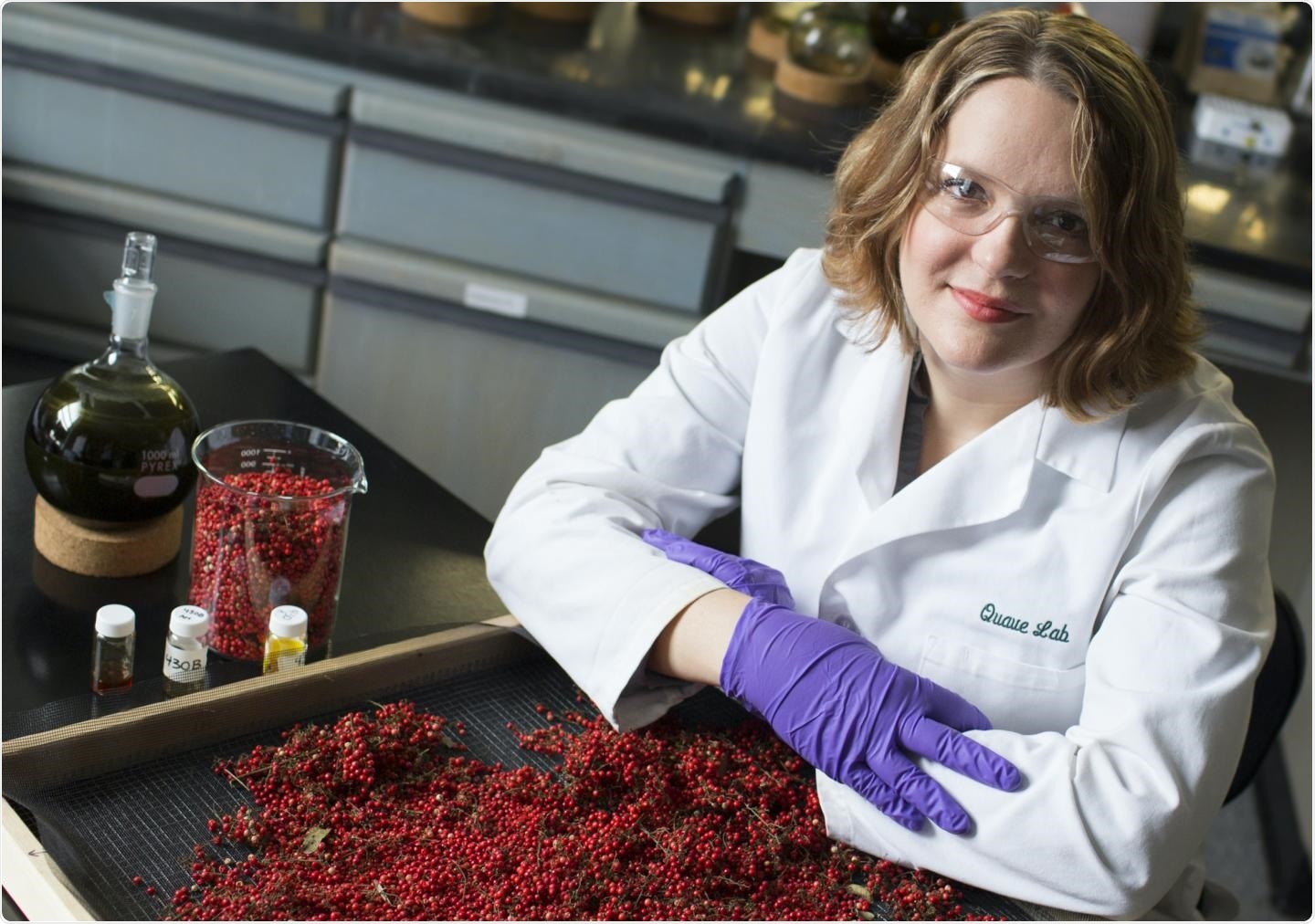Researchers have discovered that the Brazilian peppertree, an invasive, weedy shrub found in Florida, contains specific compounds that lower the virulence of Staphylococcus bacteria that are resistant to antibiotics.

Emory University ethnobotanist Cassandra Quave, shown in her lab with berries from the Brazilian peppertree. The plant is native to South America where traditional healers in the Amazon have used it as a treatment for skin infections. Image Credit: Emory University.
The study, published in the Scientific Reports journal, demonstrates that triterpenoid acids present in the red berries of the Brazilian plant “disarm” dangerous Staphylococcus bacteria by inhibiting its potential to release toxins.
The research was headed by the laboratory of Cassandra Quave, an assistant professor in the Emory School of Medicine’s Department of Dermatology and Emory University’s Center for the Study of Human Health.
The laboratory experiments conducted by the researchers offered the initial evidence that triterpenoid acids can have a major impact on MRSA, which stands for methicillin-resistant Staphylococcus aureus.
Native to South America, the Brazilian peppertree (Schinus terebinthifolia) also grows abundantly in Florida, where it produces dense thickets crowding out native species.
It is a noxious weed that many people in Florida hate, for good reason. But, at the same time, there is this rich lore about the Brazilian Peppertree in the Amazon, where traditional healers have used the plant for centuries to treat skin and soft tissue infections.”
Cassandra Quave, Ethnobotanist and Assistant Professor, Center for the Study of Human Health, Emory University
Quave is also a member of the Emory Antibiotic Resistance Center and a leader in the field of medical ethnobotany. She studies how smart people use plants in healing practices to reveal potentially candidates for novel drugs.
The Centers for Disease Control and Prevention has defined antibiotic resistance as “one of the biggest public health challenges of our time.” Every year in the United States, antibiotic-resistant infections affect at least 2.8 million people, leading to over 35,000 deaths.
Even in the midst of the current viral pandemic of COVID-19, we can’t forget about the issue of antibiotic resistance.”
Cassandra Quave, Ethnobotanist and Assistant Professor, Center for the Study of Human Health, Emory University
She observed that antibiotics are being given to many COVID-19 patients to treat secondary infections caused by the individuals’ debilitated conditions, raising concerns about a subsequent surge in antibiotic-resistant infections.
The Quave lab published a result in 2017 that the refined, flavone-rich mix of 27 compounds derived from the Brazilian peppertree berries prevents the formation of skin lesions in MRSA-infected mice.
The extract does not kill the MSRA bacteria but rather represses a gene that permits the bacterial cells to interact with each other. That communication can be blocked to prevent the bacterial cells from taking collective action, which actually disables the pathogens by inhibiting it from releasing the toxins they use to damage the tissues. This means, the immune system of the body stands a better chance of healing a wound.
That method is different from the usual treatment of blasting the dangerous bacteria with drugs developed to destroy them, which can help drive the issue of antibiotic resistance. A few stronger bacteria may withstand the onslaught of these drugs and proliferate, and thus pass on their genes to their offspring, which may lead to the emergence of deadly “superbugs.”
In the present study, the scientists wished to reduce the scope of 27 crucial compounds from the berries to separate the particular chemicals involved in disarming the MRSA. They carefully refined the original compounds, analyzing each new iteration for its potency on the pathogens.
A range of analytical chemistry techniques, such as X-ray crystallography, nuclear magnetic resonance spectroscopy, and mass spectrometry, were employed by the scientists to obtain a clear idea of the chemicals involved in the anti-virulence mechanism.
The outcomes demonstrated that three triterpenoid acids worked correspondingly well at blocking the MRSA bacteria from forming toxins in a petri dish, without affecting the human skin cells. One of the triterpenoid acids worked particularly well at blocking the ability of the MRSA bacteria to form lesions on the mice’s skin.
The scientists also showed that in addition to repressing a single gene that is used by MRSA to release toxins, the triterpenoid acids also repressed two genes involved in that process.
Quave stated, “Nature is the best chemist, hands down.” She added that in particular, weeds are likely to have fascinating chemical arsenals that they may utilize to guard themselves against various diseases so that they can spread in new environments more easily.
The researchers have planned to do additional studies to test the triterpenoid acids as viable treatments for MRSA infections in animal models. If those studies prove to be encouraging, the subsequent step would be to work with medicinal chemists to improve the compounds for delivery, efficacy, and safety prior to testing on humans.
Plants are so incredibly complex chemically that identifying and isolating particular extracts is like picking needles out of haystacks, When you’re able to pluck out molecules with medicinal properties from these complex natural mixtures, that’s a big step forward to understanding how some traditional medicines may work, and for advancing science towards a potential drug development pathway.”
Cassandra Quave, Ethnobotanist and Assistant Professor, Center for the Study of Human Health, Emory University
Source:
Journal reference:
Tang, H., et al. (2020) Triterpenoid acids isolated from Schinus terebinthifolia fruits reduce Staphylococcus aureus virulence and abate dermonecrosis. Scientific Reports. doi.org/10.1038/s41598-020-65080-3.